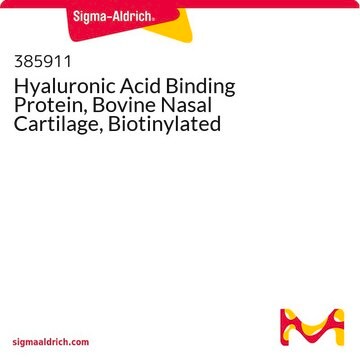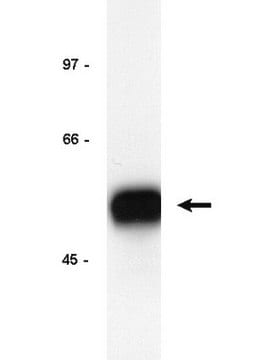03-111
RIPAb+ AUF1 - RIP Validated Antibody and Primer Set
from rabbit
Synonym(s):
Heterogeneous nuclear ribonucleoprotein D0, AU-rich element RNA-binding protein 1
About This Item
Recommended Products
biological source
rabbit
Quality Level
antibody form
purified immunoglobulin
clone
polyclonal
species reactivity
human, rat, mouse
manufacturer/tradename
RIPAb+
Upstate®
technique(s)
RIP: suitable
immunoprecipitation (IP): suitable
western blot: suitable
NCBI accession no.
UniProt accession no.
shipped in
dry ice
Gene Information
human ... HNRNPD(3184)
General description
AUF1 is a bcl2 mRNA binding protein and potentially all its isoforms are able to form complexes with the bcl2 ARE. ARE mediated bcl2 mRNA downregulation during apoptosis involves AUF1 and suggest different roles for its four isoforms.
Specificity
Immunogen
Application
RIP lysate from HeLa cells (2 X 106 cell equivalents per IP) was subjected to immunoprecipitation using 0.5 µg of either a normal rabbit IgG or Anti-AUF1 antibody. Precipitated proteins (Lane 1: rabbit IgG, Lane 2: anti-AUF1) and HeLa whole cell lysate (Lane 3) were resolved by electrophoresis, transferred to nitrocellulose and probed with anti-AUF1 antibody (1.0 µg/mL).
Proteins were visualized using One-Step IP-Western kit (GenScript Cat. # L00231) (Please see figures).
Western Blot Analysis: 0.01-1 µg/mL of a previous lot detected AUF1 in RIPA lysates from HeLa nuclear extract and A431 cells.
Epigenetics & Nuclear Function
RNA Metabolism & Binding Proteins
RNA Binding Protein (RBP)
Packaging
Quality
RIP Lysate prepared from HeLa cells (2 X 107 cell equivalents per IP) were subjected to immunoprecipitation using 5 µg of either a normal rabbit IgG or 5 µg of Anti-AUF1 antibody and the Magna RIP® RNA-Binding Protein Immunoprecipitation Kit (Cat. # 17-700).
Successful immunoprecipitation of AUF1-associated RNA was verified by qPCR using RIP Primers FOS (Please see figures).
Please refer to the Magna RIP (Cat. # 17-700) or EZ-Magna RIP (Cat. # 17-701) protocol for experimental details.
Target description
Physical form
Normal Rabbit IgG. One vial containing 125 μg Rabbit IgG in 125 μL storage buffer containing 0.05% sodium azide. Store at -20°C.
RIP Primers, FOS. One vial containing 75 μL of 5 μM of each primer specific for human FOS. Store at -20°C.
FOR: GAG AGC TGG TAG TTA GTA GCA TGT TGA
REV: AAT TCC AAT AAT GAA CCC AAT AGA TTA GTT A
Storage and Stability
Handling Recommendations: Upon receipt, and prior to removing the cap, centrifuge the vial and gently mix the solution. Aliquot into microcentrifuge tubes and store at -20°C. Avoid repeated freeze/thaw cycles, which may damage IgG and affect product performance. Note: Variability in freezer temperatures below -20°C may cause glycerol containing solutions to become frozen during storage.
Analysis Note
Includes negative control rabbit IgG antibody and control primers specific for human FOS.
Legal Information
Disclaimer
Storage Class Code
12 - Non Combustible Liquids
Flash Point(F)
Not applicable
Flash Point(C)
Not applicable
Certificates of Analysis (COA)
Search for Certificates of Analysis (COA) by entering the products Lot/Batch Number. Lot and Batch Numbers can be found on a product’s label following the words ‘Lot’ or ‘Batch’.
Already Own This Product?
Find documentation for the products that you have recently purchased in the Document Library.
Our team of scientists has experience in all areas of research including Life Science, Material Science, Chemical Synthesis, Chromatography, Analytical and many others.
Contact Technical Service








